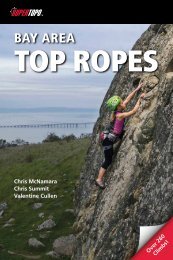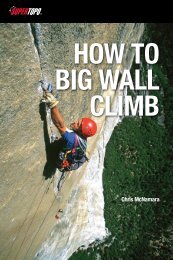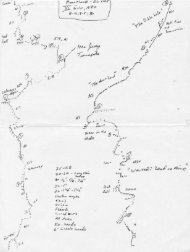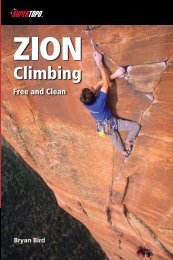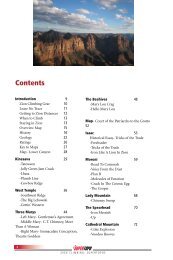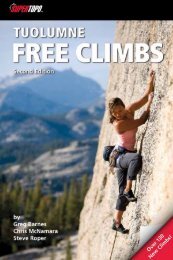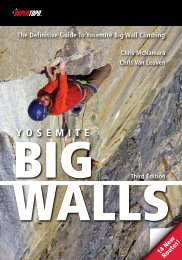Yosemite Sport Climbs and Top Ropes - SuperTopo
Yosemite Sport Climbs and Top Ropes - SuperTopo
Yosemite Sport Climbs and Top Ropes - SuperTopo
You also want an ePaper? Increase the reach of your titles
YUMPU automatically turns print PDFs into web optimized ePapers that Google loves.
Valley <strong>Sport</strong> Climbing:<br />
The Chapel Wall<br />
By Pete Takeda<br />
“I never knew there was any sport climbing<br />
in <strong>Yosemite</strong>.”<br />
– Ben Alex<strong>and</strong>ra, 2010<br />
By the mid-to-late 80s, climbing in<br />
<strong>Yosemite</strong> was passing through an era of<br />
grade advancement <strong>and</strong> breathtaking<br />
new route development. From a cragging<br />
perspective, the majority of obvious, easily<br />
accessible crack climbs had been freed, 70s<br />
testpieces had been free-soloed, <strong>and</strong> new<br />
routing was saddled with now-irrelevant<br />
concerns about “hang-dogging” <strong>and</strong><br />
lycra, <strong>and</strong> the ethical distinction between<br />
placing a bolt from a stance or a hook. The<br />
approved, then-contemporary hardman<br />
style featured tube socks, <strong>and</strong> stiff, high-top<br />
boots. It focused on ascending incipient,<br />
discontinuous cracks <strong>and</strong> often-crusty faces<br />
whose relatively low angle lent a fussy/techy<br />
difficulty – rather than the athletic/pumpy<br />
style we equate with today’s steep, bolted<br />
testpieces. Looking back now, it seems so<br />
quaint.<br />
This era was also a gray zone in the<br />
timetable of the bigger climbing tides. It was<br />
the cusp of the sport climbing “revolution,”<br />
the gray zone between widespread<br />
acceptance of rappel bolting. One of the<br />
first rap-bolted, semi-sport climbs is the<br />
“airy” Wheat Thin (5.10c) by Peter Haan<br />
<strong>and</strong> Jim Bridwell in 1971. Over the next<br />
several decades steep sport areas were<br />
established like Killer Pillar, (5.11d-5.12c),<br />
The Knobby Wall (5.10b-5.13b), The Chapel<br />
Wall (5.11d-5.13b), Public Sanitation<br />
(5.10d-5.13b), Mecca (5.10c-5.14), <strong>and</strong><br />
more. They were put up in a myriad<br />
of styles, putting <strong>Yosemite</strong> on the sport<br />
climbing map.<br />
The development of sport-climbing<br />
routes in the Valley was non-linear <strong>and</strong><br />
more of a general trend rather than a<br />
“movement.” Its proponents were diverse<br />
22<br />
<strong>and</strong> too numerous to name. The general<br />
trend had its origin with on-lead stance<br />
drilling of slabbier face climbs. As climbers<br />
sought steeper <strong>and</strong> steeper routes, which<br />
often required judicious cleaning, hooks,<br />
aiders, pins, <strong>and</strong> other forms of aid became<br />
the norm for first ascentionists. A good<br />
example of development using such tactics<br />
is the Chapel Wall, with first ascentionists<br />
logging countless seasons of wire-brushing,<br />
on-lead h<strong>and</strong> drilling of 5/16” button-head<br />
bolts, <strong>and</strong> the transformations of old top<br />
rope routes.<br />
Though these tactics adhered to the letter<br />
of the traditional “ground-up” approach<br />
to establishing new routes, this tactic<br />
became a loophole for first ascentionists<br />
that sometimes left much to be desired.<br />
For example, some climbs w<strong>and</strong>ered in<br />
seemingly drunken lines of bolts that ended<br />
at arbitrary two-bolt belays. Others routes<br />
resembled bolt ladders – which sometimes<br />
they were – while others were noteworthy<br />
for the amount of scrubbing time <strong>and</strong> the<br />
number of broken wire brushes required<br />
to force a line through an otherwise<br />
unremarkable swell of lichen-crusted<br />
granite.<br />
Amazingly, some routes still shined<br />
despite their less-than-mega-classic<br />
appearance, <strong>and</strong> attracted enough repeat<br />
traffic to evolve. Generally speaking,<br />
Chapel Wall seemed to avoid the worst<br />
transgressions of chipping, bondo<br />
reinforcement, heavy-h<strong>and</strong>ed retrobolting<br />
<strong>and</strong> the odd bolt-on hold found on other<br />
<strong>Yosemite</strong> sport era cliffs such as Taft Point.<br />
But then again, Knobby Wall was chipped<br />
<strong>and</strong> it is about as pedestrian as any wall gets.<br />
By the late 80s to early 90s, climbing<br />
st<strong>and</strong>ards for <strong>Yosemite</strong> sport routes were<br />
approaching mid-5.13. The quality range<br />
was sweetest in the 5.11 to mid-5.12 range,<br />
as exemplified by Drive by Shooting (5.12a),<br />
The Great Escape (5.11c, five pitches), <strong>and</strong><br />
Ninety Six Degrees in the Shade (5.12c).<br />
It was during this stage of <strong>Yosemite</strong>’s<br />
sport-climbing evolution – immediately<br />
before Ken Yager first bolted chunks of<br />
s<strong>and</strong>ed hardwood onto the crude wooden<br />
lattice in his El Portal garage, thus creating<br />
<strong>Yosemite</strong>’s first indoor-climbing wall – that<br />
Y O S E M I T E S P O R T C L I M B S A N D T O P R O P E S : S U P E R T O P O<br />
S P O R T C L I M B I N G H I S T O R Y




